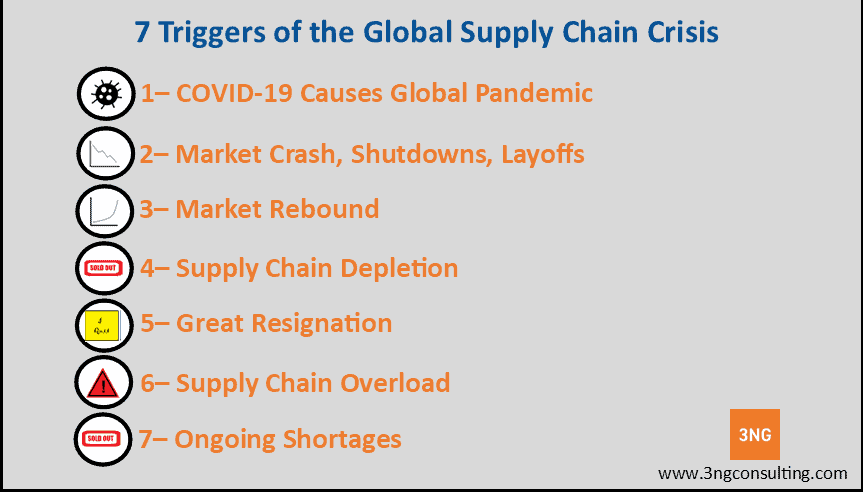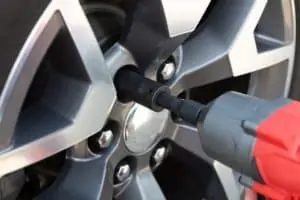It’s hard to debate that the Automotive Industry is suffering from a global supply chain crisis. Parts availability is low, supplies are unreliable and new car supply has been hampered. Not to mention that automaker fill rates are down to 80% and lower for service parts.
And this shortage is impacting the global economies. For example, around 30% of US inflation is tied directly to rises in new and used car pricing.
While there are many supply chain causes, the root causes all point to a supply chain crisis created by unanticipated supply chain risks. And comes down to a major tenet of the Toyota Production System that has been minimiz – Build product near your customers.
Global Supply Chain Crisis
It’s clear that globalization has been good for business. And nearly every country that has open itself up for trade over the past 30 years has benefitted tremendously. Some of the many benefits include increased GDPs, improved corporate profits, decreased unemployment and an expanded tax base.
What has been missed is that the global supply chain has been remarkably stable. And the trend among trading nations has been trending toward stability and away from entropy. This has allowed for just in time inventory planning processes to achieve incredible cost savings and absorb fluctuations in demand.
Unfortunately, the COVID Pandemic followed by Russia’s invasion of Ukraine have tuned the JIT management process on its ear. And this has not just affected the automotive industry. Who can forget mask shortages in hospitals, runs on toilet paper and shortages of bottled water?
The Trigger Events
There is a very clear sequence of events that triggered the supply chain crisis as shown in the illustration. The 7 triggers that snowballed into the supply chain crisis. But how did this create the global supply chain issue?

The process begins with a fully optimized JIT supply chain. When companies shut down operations and employees were laid off, the market expected a sharp decline in demand. And while there was a short-term decline, demand rebounded much faster than expected.
And as demand came back, short safety stocks combined with shuttered factories caused the market to rapidly consume available safety stock. And as each warehouse in the supply chain consumed the previous warehouses buffer stock, the amount of safety stock was completely consumed by rising demand.
Typically, when this occurs, the production process will support a supplier ramp up. However, ongoing COVID shutdowns and the emergence of the Great Resignation added further stress to the manufacturing process and hampered the ability for suppliers to respond.
The Market Impact
The supply chain crisis has been global in origin and impact. US Vehicle sales were around 14.2M versus a fulfillable demand of over 16 million vehicles. These supply shortages have cost the automakers billions of dollars in Sales. And new cars have not been the only segment effected.
Dealer Fixed Operations have also taken a hit. Automaker fill rates have dropped from their pre-pandemic levels of over 97% to 80% or lower. It’s difficult for a service department to install parts that aren’t availalbe. And the impact to the wholesale markets have been even more severe, with body shops waiting weeks to receive parts.
Ultimately, success with global outsourcing and supply chain management created the vulnerability. And the focus on reducing holding costs created safety inventory management that was effective in a stable market but were unsustainable when the marketplace became unstable.
Moving Forward
It’s easy to look at what went wrong, but it is difficult to find the solution. And while there are few short-term solutions to the current global supply chain crisis, there are opportunities for long-term adaptations.
When Professor Deming observed the Mass Production Process, he identified that the singular goal on maximizing labor was creating waste in the process. The fallout from the Pandemic is exposing that the singular goal of reducing supply chain costs has created a supply chain vulnerability.
Medium and long term is showing the need to reduce supply chain risks. There are 2 ways this can be achieved. The first is by maintaining the current supply chain strategy and create buffers to protect against further downturns.
This starts with changing the safety stock calculations, increasing inventory levels and adding redundant suppliers. This can help reduce the risk for future downturns, but still leaves the suppy chain vulnerable to disruption.
The second method is to purchase from suppliers located near the point of sale. So, if a product is being sold in the United States, the final assembly and components should be built in North America. This may have a unit cost increase, but shortens the supply chain and lowers the risk from geopolitical unrest and global crises.
There are risks and benefits for each, so it is beneficial for each business to review their options and make the decision that’s best for their product or service.
About 3NG Consulting
We are a full-service automotive consulting company. Our team specializes in fixed ops products and fixed operations consulting. Our team specializes in Channel Balancing – a process that leverages the strength of dealers, automakers and suppliers to provide a balanced channel that offers the highest possible service.
Click here for more information on our Automotive Consulting Services and our Dealer Consulting Group.






